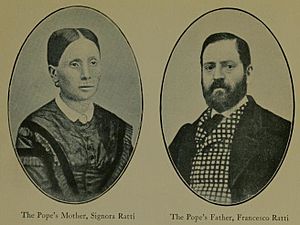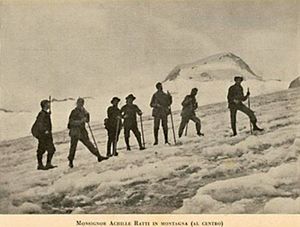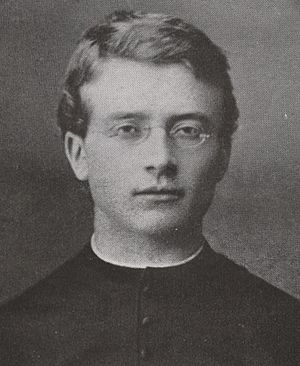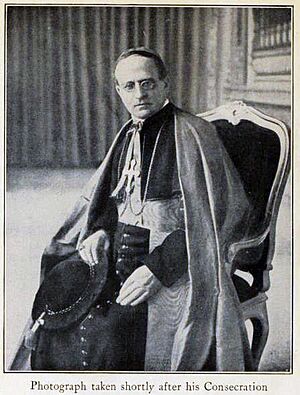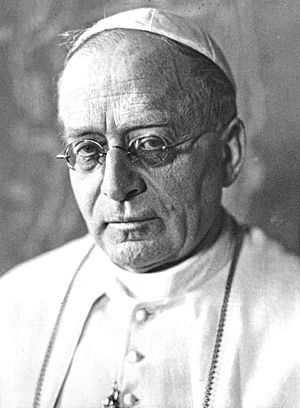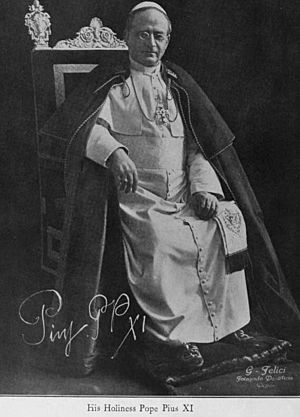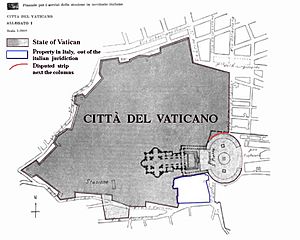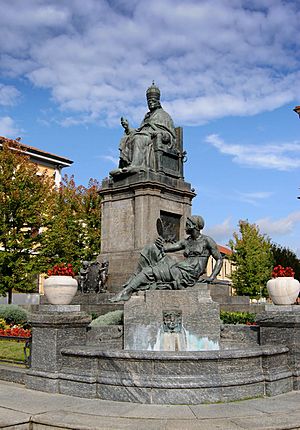Pope Pius XI facts for kids
Quick facts for kids Pope Pius XI |
|
|---|---|
| Bishop of Rome | |
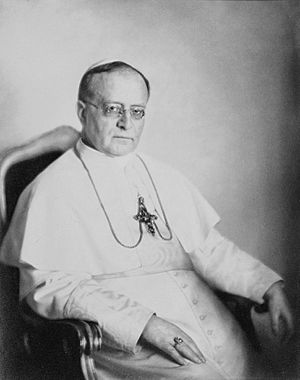
Portrait by Nicola Perscheid, c. 1922
|
|
| Church | Catholic Church |
| Papacy began | 6 February 1922 |
| Papacy ended | 10 February 1939 |
| Predecessor | Benedict XV |
| Successor | Pius XII |
| Orders | |
| Ordination | 20 December 1879 |
| Consecration | 28 October 1919 by Aleksander Kakowski |
| Created Cardinal | 13 June 1921 |
| Personal details | |
| Birth name | Ambrogio Damiano Achille Ratti |
| Born | 31 May 1857 Desio, Lombardy–Venetia, Austrian Empire |
| Died | 10 February 1939 (aged 81) Apostolic Palace, Vatican City |
| Previous post |
|
| Education | Pontifical Gregorian University (ThD, JCD, PhD) |
| Motto | Raptim Transit ("It goes by swiftly", Job 6:15) Pax Christi in Regno Christi (The Peace of Christ in the Realm of Christ) |
| Signature |  |
| Coat of arms |  |
| Other Popes named Pius | |
Pope Pius XI, born Ambrogio Damiano Achille Ratti, led the Catholic Church from February 6, 1922, until his death in February 1939. He was the first leader of Vatican City when it became its own independent country on February 11, 1929. His special motto as pope was "Pax Christi in Regno Christi," which means "The Peace of Christ in the Kingdom of Christ."
Pius XI wrote many important letters called encyclicals. One was Quadragesimo anno, which talked about fair wages and social justice. It was written 40 years after another important letter by Pope Leo XIII called Rerum novarum. Pius XI also wrote Quas primas, which created the feast of Christ the King. This was a response to people who were against the Church.
He signed many agreements called concordats with different countries. This helped the Catholic Church keep its place in the world. One important agreement was the Lateran Treaty in 1929, which settled a long disagreement with the Italian government. This treaty made Vatican City an independent state. However, he could not stop the persecution of the Church in Mexico, Spain, and the Soviet Union.
Pius XI made many important people saints, like Thomas More and Don Bosco. He also helped more regular people get involved in the Catholic Church through the Catholic Action movement. Towards the end of his time as pope, he spoke out strongly against leaders like Hitler and Mussolini. He defended the Catholic Church from their attempts to control religious life and education.
Pope Pius XI passed away on February 10, 1939, in the Apostolic Palace. He is buried in the special Papal Grotto under Saint Peter's Basilica. When they were digging for his tomb, they found bones that many believe belong to Saint Peter.
Contents
Early Life and Career
Ambrogio Damiano Achille Ratti was born in Desio, Italy, in 1857. His father owned a silk factory. He had five siblings. He became a priest in 1879 and studied a lot. He earned three doctorates (special degrees) in philosophy, canon law (Church law), and theology (study of religion) from the Gregorian University in Rome.
From 1882 to 1888, he taught at a seminary in Padua. He was an expert in paleography, which is the study of old Church writings. Later, he worked full-time at the Ambrosian Library in Milan from 1888 to 1911.
While at the Ambrosian Library, Ratti helped restore and organize its collection. He also loved mountain climbing in his free time. He climbed famous mountains like Monte Rosa and the Matterhorn. In 1911, Pope Pius X asked him to work at the Vatican Library. He became its head in 1914.
Papal Representative in Poland
In 1918, Pope Benedict XV asked Ratti to become a diplomat. He was sent to Poland as an unofficial papal representative. Poland had just become an independent country again. In 1919, Ratti became the official papal nuncio (ambassador) to Poland. He was made an archbishop in October 1919.
Both Pope Benedict XV and Ratti warned Polish leaders not to persecute other Christian groups. During a war when the Red Army was close to Warsaw, Ratti was the only foreign diplomat who stayed in the city. He wanted to build peace between Poland and the Soviet Union. However, some people in Poland did not like his contacts with Russians. He was eventually asked to leave Poland.
Becoming Pope
In June 1921, Pope Benedict XV made Ratti a cardinal and the Archbishop of Milan. The pope joked that one of the new cardinals would soon wear white, meaning become pope. After Pope Benedict XV died in January 1922, the cardinals met to choose a new pope. This meeting, called a conclave, was the longest of the 20th century.
The cardinals were divided, but they eventually chose Ratti as a compromise. He was elected pope on February 6, 1922. He chose the name "Pius XI." He said he chose it because Pope Pius IX was the pope of his youth, and Pope Pius X had given him important jobs. He also said "Pius is a name of peace."
As his first act, Pope Pius XI brought back the traditional public blessing, Urbi et Orbi ("to the city and to the world"). This blessing had not been given by popes since 1870, when Rome was taken by the Italian state. This showed he was open to making peace with the Italian government.
Pope Pius XI's Teachings
Pius XI wanted Christian values to be part of all areas of society. His first encyclical, Ubi arcano (December 1922), started the "Catholic Action" movement. This movement encouraged regular people to get more involved in the Church's work.
He also wrote about education and marriage. Divini illius magistri (1929) stressed the importance of Christian education. Casti connubii (1930) praised Christian marriage and family life as the foundation of a good society.
Social Teachings
Pius XI believed that economic and political life should be based on religious values. In Quadragesimo anno (1931), he warned against both socialism and uncontrolled capitalism. He saw both as threats to human freedom. Instead, he wanted an economy based on cooperation and fairness.
He said that social and economic issues are important to the Church because of their moral side. He talked about private property and said it was important for individual freedom. But he also said it must serve the common good. Governments, he said, could even redistribute wealth in extreme cases.
Pius XI also discussed fair wages. He believed that workers should earn enough to support their families. He stressed that businesses and the economy as a whole must be healthy for this to happen. He thought that cooperation between employers and employees was essential.
He worried that industrialization could lead to less freedom for individuals. He saw dangers in large, anonymous financial markets. He warned that powerful financial interests could harm nations.
Pius XI was the first pope to use modern communication technology. He started Vatican Radio in 1931 and was the first pope to broadcast on radio.
Church Affairs and Unity
Pius XI continued to focus on spreading Catholicism in Africa and Asia. He also made sure that local priests were trained in these mission areas. He asked all religious orders to help with missionary work.
He was against modernism, which he saw as ideas that changed basic Catholic teachings. However, he supported new scientific study within the Church as long as it fit with Church teachings. He founded the Pontifical Academy of Sciences in 1936.
Pius XI strongly encouraged devotion to the Sacred Heart in his encyclical Miserentissimus Redemptor (1928).
He was also the first pope to directly address the Christian ecumenical movement. He wanted to reunite with the Eastern Orthodox Church. He also allowed discussions between Catholics and Anglicans. However, he believed that Christian unity meant other Christians returning to the Catholic Church. In his 1928 encyclical, Mortalium animos, he said that Christian unity could not be achieved by just joining different groups with different beliefs.
The next year, the Vatican successfully asked the Italian government to require Catholic religious education in all schools. This included schools with mostly Protestants or Jews.
Saints and Cardinals
Pius XI made 34 people saints during his time as pope. These included Bernadette Soubirous (1933), Therese of Lisieux (1925), and John Bosco (1934). He also beatified (the step before sainthood) 464 people.
He named four individuals as Doctors of the Church, which means their writings are very important for Catholic teaching. These included Peter Canisius (1925) and Albert the Great (1931).
Pius XI created 76 cardinals in 17 different ceremonies. One of these cardinals was Eugenio Pacelli, who later became Pope Pius XII. Pius XI believed Pacelli would be his successor. He even told new cardinals, "He'll make a good pope!"
International Relations
Pius XI's time as pope was right after World War I. Many old European kingdoms were gone, and new countries were forming. The Soviet Union was rising in the East. In Italy, Benito Mussolini became a dictator, and in Germany, the Nazi party took power.
Pius XI worked hard to make agreements, called concordats, with many countries. He signed 18 such treaties. However, some of these agreements did not last.
He was very worried about the rise of totalitarian governments. He wrote three encyclicals against these new ideas:
- Against Italian Fascism: Non abbiamo bisogno (1931)
- Against Nazism: Mit brennender Sorge (1937)
- Against atheist Communism: Divini redemptoris (1937)
He also spoke out against extreme nationalism and anti-Semitism.
Relations with Italy
Pius XI wanted to end the long disagreement between the papacy and the Italian government. For many years, popes had refused to recognize the Italian state after it took over the Papal States in 1870. The popes had considered themselves "prisoners in the Vatican."
Benito Mussolini, the Italian leader, also wanted an agreement. After years of talks, the Lateran Treaties were signed in 1929. This agreement made Vatican City an independent country. Pius XI became a head of state, the first pope to be one since the 1800s. The treaty also recognized Catholicism as the official religion of Italy.
The agreement also gave the Vatican money for Church property taken since 1860. Pius XI invested this money wisely, which helped pay for the upkeep of the Vatican's historic buildings.
However, relations with Mussolini's government worsened after 1930. Mussolini wanted to control the Church's youth groups. Pius XI responded with the encyclical Non abbiamo bisogno (1931). It criticized the government's actions and its "pagan worship of the State."
Relations with Germany
After the Nazis took power in Germany in 1933, they began to persecute the Catholic Church. Adolf Hitler wanted to remove the Church's political influence. The Vatican, led by Cardinal Eugenio Pacelli (who would become Pope Pius XII), signed the Reichskonkordat with Germany in June 1933. This agreement was supposed to protect the Church's freedom and organizations.
However, the Nazis quickly broke the agreement. They arrested clergy and closed Catholic schools and groups.
Mit brennender Sorge
By early 1937, the Church in Germany was very unhappy with the Nazis. In March, Pope Pius XI issued the encyclical Mit brennender Sorge ("With Deep Concern"). This letter accused the Nazi government of breaking the agreement and spreading "hatred" against Christ and the Church. The pope warned of "threatening storm clouds" of religious wars.
Copies of the encyclical were secretly brought into Germany. It was read aloud in all Catholic churches. The Nazis reacted by increasing their attacks on the churches. They arrested many clergy and took over Church printing presses.
Kristallnacht
When the Nazis started their anti-Jewish program in 1933, Pius XI asked his representative in Berlin to help. On November 11, 1938, after Kristallnacht (a violent attack on Jews), Pius XI joined other world leaders in condemning the violence.
In response, the Nazis held protests against Catholics and Jews. On November 21, Pius XI spoke to Catholics worldwide. He rejected the Nazi idea of racial superiority, saying there was only one human race. Nazi leaders responded by saying they did not agree with the Pope.
Relations with East Asia
Pius XI also dealt with the rise of Japan and the unification of China. In 1922, he sent a special representative to China. In 1928, he supported China's political unity. When Japan created the state of Manchukuo in 1931, the Vatican recognized it.
Persecution of Christians
Pius XI faced severe persecution of the Catholic Church in Mexico and Spain. He also saw persecution of all Christians in the Soviet Union. He called this a "terrible triangle."
Soviet Union
Pius XI was worried about the persecution of Christians in the Soviet Union. He asked his representative, Eugenio Pacelli, to try to make diplomatic agreements. Pacelli tried to negotiate, but the Soviets rejected religious education and ordaining priests. The secret talks ended in 1927 because they were not working.
Persecution continued in the 1930s. Many clergy were executed or exiled. Churches were closed, and Church property was taken.
Mexico
During Pius XI's time, the Catholic Church faced extreme persecution in Mexico. Over 5,000 priests, bishops, and followers died. In some areas, the Church was completely outlawed. Pius XI protested these actions in his encyclicals Iniquis afflictisque (1926) and Acerba animi (1932). Problems continued until 1940.
Before the rebellion, there were 4,500 Mexican priests. By 1934, over 90% of them were persecuted. Only 334 priests were allowed to serve 15 million people. By 1935, 17 Mexican states had no priests at all.
Spain
The government that came to power in Spain in 1931 was against the Church. It made education secular and banned religious teaching in schools. It also expelled the Jesuits. In 1932, Pius XI protested these actions.
Condemnation of Racism
When Italy started to adopt anti-Semitic laws like Germany in 1938, Pius XI publicly asked Italy not to. He said that the idea of "race" divides people. He believed in the "unity of human society," which includes many differences. He said Italy, a civilized country, should not copy Germany's harsh laws.
Pius XI planned to write an encyclical called Humani generis unitas (The Unity of the Human Race). It would speak out against racism and anti-Semitism in the United States, Europe, and elsewhere. However, he died before he could issue it.
His successor, Pius XII, later issued his own encyclical, Summi Pontificatus, which also talked about the unity of humanity.
Personality
Pius XI was known as a direct and serious man. He loved science and was fascinated by radio. He used new technologies during his time as pope. He was also known for rarely smiling.
He could have a temper sometimes. He believed strongly in the dignity of his office. He always ate alone and would not let his assistants dine with him. When his brother and sister visited, they had to call him "Your Holiness" and make an appointment.
He was very demanding and had high standards. For example, he once made Angelo Roncalli (the future Pope John XXIII) kneel for 45 minutes as punishment for a diplomatic mistake. But when he found out Roncalli was not truly at fault, he apologized to him.
| Papal styles of Pope Pius XI |
|
|---|---|
 |
|
| Reference style | His Holiness |
| Spoken style | Your Holiness |
| Religious style | Holy Father |
| Posthumous style | None |
Death and Burial
Pius XI had been sick for some time. In November 1938, he had two heart attacks. He had trouble breathing and could not leave his apartment. He gave his last big speech to the Pontifical Academy of Sciences, which he had founded. He spoke about the connection between science and the Catholic faith.
Pius XI died at 5:31 a.m. on February 10, 1939, at 81 years old. He died from a third heart attack. His last words were clear: "My soul parts from you all in peace."
After his death, many leaders sent their condolences, including Benito Mussolini and Adolf Hitler. Flags were flown at half-staff in Rome, Paris, and Berlin.
Pius XI's body was placed in a wooden coffin, then a bronze casket, and finally a lead casket. He was buried in the crypt of St. Peter's Basilica on February 14, 1939. His tomb is near the tomb of Saint Peter.
Legacies
Pius XI is remembered as the pope who led the Church between the two big World Wars. He also reorganized the Vatican archives. He was not just a scholar; he was also a famous mountain climber. Many peaks in the Alps are named after him because he was the first to climb them.
A glacier in Chile is named after Pius XI. In 1940, a climbing club in the United Kingdom was named the Achille Ratti Climbing Club in his honor.
Pius XI also re-established the Pontifical Academy of Sciences in 1936. He wanted it to be the "scientific senate" of the Church. He appointed over eighty scientists from different countries and backgrounds. In his honor, Pope John XXIII created the Pius XI Medal. This medal is given to young scientists under 45 who have done important work.
The Syro-Malankara Catholic Church founded a school named after him in India. Pius XI High School in Milwaukee, Wisconsin, founded in 1929, is also named in his honor.
See also
 In Spanish: Pío XI para niños
In Spanish: Pío XI para niños
- Cardinals created by Pius XI
- List of encyclicals of Pope Pius XI
- Pope Pius XI and Judaism


